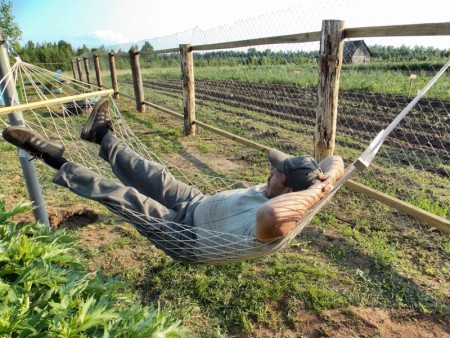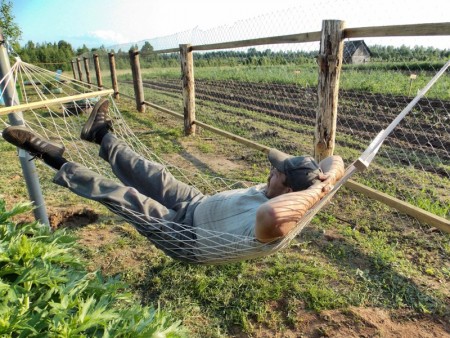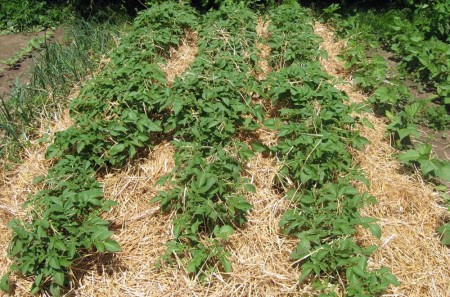“We have a personal plot, which is used mainly for vegetable crops. But this year there is no one to take care of the garden; the plot will be visited 2-3 times a month. Next year the situation will remain the same. I don't want the ground to become overgrown with weeds.
Please advise what to sow (plant) on the site, which crops require a minimum of care? Or just cut down the weeds 1-2 times a month and treat with herbicide? The soil on the site is poorly fertilized (sandy loam)."
Which crops do not require special care?
The fact that you will have the opportunity to visit the site 2-3 times a month is already good. With this regime, you don’t have to give up your garden by planting more or less drought-resistant plants.
The first thing that comes to mind is melons. Watermelons can grow without watering. And if you water them once or twice a month after they grow and take deep roots, a harvest is guaranteed.
The problem is different: you need to take care of the safety of the crop. The fact is that ripening watermelons like to be pecked by crows, magpies, and rooks. And you need to think about protection: hide the fruits under the grass, cover them with non-woven material on the arches.
Melons and pumpkins can also get by with infrequent watering; they also require minimal care. You can sow sweet corn and tomatoes.
Sunflowers are content with occasional watering, but it is better to avoid sowing them. This crop greatly depletes the soil. In addition, you may not see the seeds: sparrows like to feed on sunflower caps.
Plants are prepared for the fact that they will have to exist in arid conditions from the first days. Weed the seeding furrows well, sow the seeds, wait for the shoots to emerge, and don’t rush to water: let the seedlings take root deep and seek moisture. After such “asceticism” in the initial period, plants can easily get by with rare watering during the period of active growth and fruiting.
Try to keep the soil moist
Still, it’s worth thinking about how to keep the soil moist from watering to watering. Think about mulching.Last year's leaves, dried mowed grass, straw, and old sawdust will be used.
Mulching is also necessary because the soil on your site is sandy loam: it quickly overheats and dries out. When weeding the grass regularly, leave it in the spaces between the rows of the beds, on paths, under bushes and trees.
Overgrown grass can be chopped with a shovel so that it covers the soil more evenly, protecting it from overheating and drying out. It is important that the layer of mulch initially prevents the growth of weeds, and later, as it decomposes, it improves the structure of the soil and enriches it with nutrients. You can also cover the soil with sheets of cardboard or non-woven material.
Radishes, lettuce, and dill sown under film in early spring can easily get by with spring moisture and watering during your rare visits to the dacha. You can even plant some early potatoes.
Try to plant the germinated tubers deeper than usual, and after germination, only lightly hill up the plants, forming irrigation grooves. Highly hilled potatoes require frequent watering because the soil in the ridges dries out quickly, so this agricultural technique is not for a garden that will be watered occasionally. Even before the onset of hot weather, the potato bed must be mulched.
The simplest drip irrigation systems
You can even plant a few pepper bushes or eggplants by building a small round bed for them. A water container is dug into the center of the bed. Long braids are woven from narrow strips of fabric, one end of which is lowered into a container of water, and the other is placed near a pepper or eggplant bush.
How many plants are planted around the circumference of the bed, so many braids. Then the braids are sprinkled with earth.The container is filled with water and covered with a lid. The braids, when wet, will moisten the soil in the garden bed during your absence.
You can keep the soil moist in other ways. For example, dig plastic bottles near each bush, making holes in them through which water will slowly seep. Such simple watering systems will help reduce plant care to a minimum.
When planting seedlings, you can add perlite to each hole and mix it with the soil. Perlite granules immediately after watering absorb excess moisture from the soil, and as it dries, they gradually release it. Perlite holds four times its weight in water.
Sow green manure
If you still decide that it will not be possible to grow vegetables in the coming season, use the forced downtime to improve the soil. In early spring, areas not occupied by perennial plants can be sown with mustard, oats, and barley.
Before the onset of hot weather, they will form a good green mass even without watering. As soon as the green manure plants are about to bloom, mow them down and do not remove them: let them cover the soil. At the beginning of autumn, green manure can be sown again, expanding the range with winter crops - rye, wheat, which will safely overwinter and in the spring will serve as mulch and soil improver.
Maintaining your garden this way will take you no more time than constant weeding and herbicide treatment. Keeping light soil uncovered by any vegetation all season will ruin it.
Without plant cover, the soil overheats, dries out and the beneficial microflora in it dies. In addition, light soil is very susceptible to erosion: its top layer is easily blown away by the wind and washed away by melt and rainwater.




 (10 ratings, average: 4,80 out of 5)
(10 ratings, average: 4,80 out of 5) CUCUMBERS NEVER GET SICK, I'VE BEEN USING ONLY THIS FOR 40 YEARS! I SHARE A SECRET WITH YOU, CUCUMBERS ARE LIKE THE PICTURE!
CUCUMBERS NEVER GET SICK, I'VE BEEN USING ONLY THIS FOR 40 YEARS! I SHARE A SECRET WITH YOU, CUCUMBERS ARE LIKE THE PICTURE! You can dig a bucket of potatoes from each bush. Do you think these are fairy tales? Watch the video
You can dig a bucket of potatoes from each bush. Do you think these are fairy tales? Watch the video
 How our fellow gardeners work in Korea. There is a lot to learn and just fun to watch.
How our fellow gardeners work in Korea. There is a lot to learn and just fun to watch. Eye trainer. The author claims that with daily viewing, vision is restored. They don't charge money for views.
Eye trainer. The author claims that with daily viewing, vision is restored. They don't charge money for views. A 3-ingredient cake recipe in 30 minutes is better than Napoleon. Simple and very tasty.
A 3-ingredient cake recipe in 30 minutes is better than Napoleon. Simple and very tasty. Therapeutic exercises for cervical osteochondrosis. A complete set of exercises.
Therapeutic exercises for cervical osteochondrosis. A complete set of exercises. Which indoor plants match your zodiac sign?
Which indoor plants match your zodiac sign? What about them? Excursion to German dachas.
What about them? Excursion to German dachas.
Thank you for the article. My friends and I decided to develop the dacha. We want to sow cucumbers Zyatek and Mother-in-law.The neighbors have excellent cucumbers, but they hardly care for them. This is about us!
My friends once planted cucumbers along with potatoes in a distant garden. We were there several times throughout the summer, weeded them a couple of times, didn’t water them at all, but the cucumbers still grew (in an open field), they were just slightly bitter.
I really liked your site, a lot of useful information, although I’m not new to this matter.
Thank you, Elena, for your kind words. I am also very pleased that the site was useful to you.